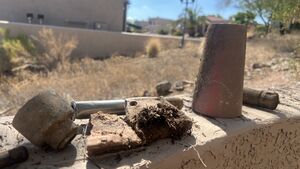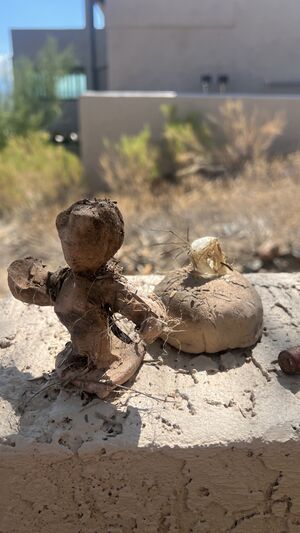Yard Model: Difference between revisions
King Horror (talk | contribs) No edit summary |
King Horror (talk | contribs) No edit summary |
||
| Line 4: | Line 4: | ||
[[File:Yard Relic 2.jpg|thumb]] | [[File:Yard Relic 2.jpg|thumb]] | ||
The Yard Model lasted for over 7 years, from the summer of 2006 until late June 2014, from the time when Agma Schwa was 7 and 14 years old. | |||
Agma Schwa and several of his friends built cities, lakes, and rivers in the red-clay soil of his parents’ yard, working together to play out battles and other historic events that roughly correspond to the chaotic period of the early [[War of the Continent]], especially between 2008 and 2013. | |||
It is from a Chilean Mesquite Tree overhanging the Yard Model that the concept of “The Ick” originated. Each April, the Mesquite Tree bloomed, dropping mass quantities of sticky flowers that made a mess in the yard. After the release of the ''Spongebob Squarepants'' episode “Fungus Among Us,” this mass of sickly yellow-green matter was associated with the fungus shown in that episode, wherein the fungus was referred to as “the Ick.” | |||
Revision as of 22:24, 14 September 2025
The Yard Model was a large section of Agma Schwa's childhood backyard that, with a hose and shovels, served as the basis for El Fwonk Casanosia.


The Yard Model lasted for over 7 years, from the summer of 2006 until late June 2014, from the time when Agma Schwa was 7 and 14 years old.
Agma Schwa and several of his friends built cities, lakes, and rivers in the red-clay soil of his parents’ yard, working together to play out battles and other historic events that roughly correspond to the chaotic period of the early War of the Continent, especially between 2008 and 2013.
It is from a Chilean Mesquite Tree overhanging the Yard Model that the concept of “The Ick” originated. Each April, the Mesquite Tree bloomed, dropping mass quantities of sticky flowers that made a mess in the yard. After the release of the Spongebob Squarepants episode “Fungus Among Us,” this mass of sickly yellow-green matter was associated with the fungus shown in that episode, wherein the fungus was referred to as “the Ick.”
